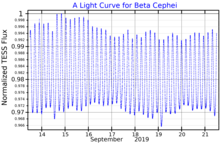Beta Cephei
| Observation data Epoch J2000 Equinox J2000 | ||
|---|---|---|
| Constellation | Cepheus | |
| Right ascension | 21h 28m 39.59685s[1] | |
| Declination | +70° 33′ 38.5747″[1] | |
| Apparent magnitude (V) | 3.16 – 3.27[2] | |
| Characteristics | ||
| Spectral type | B1 IV[3] | |
| U−B color index | –0.95[4] | |
| B−V color index | –0.22[4] | |
| Variable type | β Cep[2] | |
| Absolute magnitude (MV) | –3.03[3] | |
Semi-amplitude (K1)(primary) | 9.63 ± 0.26 km/s | |
| Details | ||
| β Cep Aa | ||
Myr | ||
| β Cep Ab | ||
| Mass | 5.0[6] M☉ | |
| J21287+7034 | ||
| Database references | ||
| SIMBAD | data | |
Beta Cephei (β Cephei, abbreviated Beta Cep, β Cep) is a
It consists of a binary pair (designated Beta Cephei A) together with a third companion (B). The binary's two components are themselves designated Beta Cephei Aa (officially named Alfirk /ˈælfərk/, the traditional name for the system)[9][10] and Ab.
Nomenclature
β Cephei (Latinised to Beta Cephei) is the system's Bayer designation. The designations of the two constituents as Beta Cephei A and B, and those of A's components - Beta Cephei Aa and Ab - derive from the convention used by the Washington Multiplicity Catalog (WMC) for multiple star systems, and adopted by the International Astronomical Union (IAU).[11]
Beta Cephei bore the traditional name Alfirk, derived from the
Visibility
Like the star
Pole Star
Beta Cephei is a visible star located within 5° of the
| Preceded by | Pole Star
|
Succeeded by |
|---|---|---|
| Errai | 5200AD to 7500AD with Iota Cephei |
Alderamin
|
Properties

Beta Cephei is a
Beta Cephei Aa is a
Beta Cephei Ab is a Be star in an 81-year orbit with the giant primary.[6] It has been resolved using speckle interferometry at a distance of 0.25" in 1972.[19] With a mass of about 5 M☉, it is likely a B-class star with a classification of B6.[6]
B Cephei B is a magnitude 7.8 A2 main sequence star 13.6" distant.[3]
Variability
Beta Cephei pulsates regularly every 4 hours 34 minutes, producing a variation in its visual brightness of 0.11 magnitudes. It is the prototype of the
References
- ^ S2CID 18759600.
- ^ Bibcode:2009yCat....102025S.
- ^ S2CID 119227033.
- ^ Bibcode:1986EgUBV........0M.
- Bibcode:1953GCRV..C......0W.
- ^ S2CID 237503492.
- S2CID 119428437.
- Centre de Données astronomiques de Strasbourg. Retrieved 2010-12-26.
- ISBN 978-1-931559-44-7.
- ^ a b "Naming Stars". IAU.org. Retrieved 18 June 2018.
- arXiv:1012.0707 [astro-ph.SR].
- ISBN 0-486-21079-0. Retrieved 2010-12-12.
- Bibcode:1944PA.....52....8D.
- ^ IAU Working Group on Star Names (WGSN), International Astronomical Union, retrieved 22 May 2016.
- ^ "WG Triennial Report (2015-2018) - Star Names" (PDF). p. 5. Retrieved 2018-07-14.
- ^ "MAST: Barbara A. Mikulski Archive for Space Telescopes". Space Telescope Science Institute. Retrieved 8 December 2021.
- ISBN 0-85248-900-5.
Fixed. A is a spectroscopic binary.
- Bibcode:2014yCat....1.2023S.
- doi:10.1086/180906.
External links
- Jim Kaler's Stars, University of Illinois:ALFIRK (Beta Cephei)
- AAVSO Variable Star of the Month, Winter 2005: The Beta Cephei Stars and Their Relatives
- An Atlas of the Universe: Multiple Star Orbits

